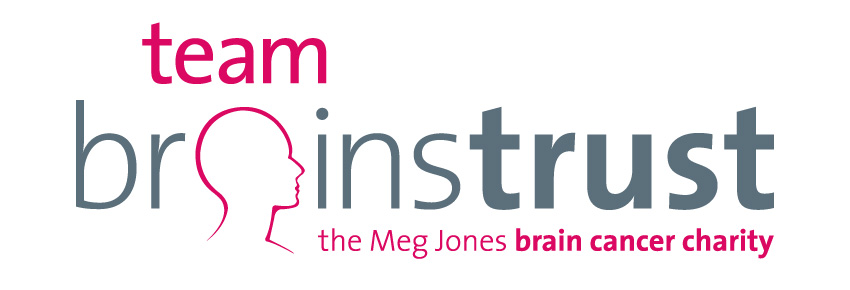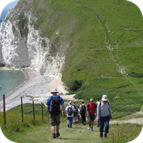 There’s been a LOT going on this year. So much so, it’s easy to gloss over some of the ‘detail’ and miss sharing with you some of the amazing feats that our patient and carer supporters undertake in order that we can continue to offer our unique and personalised support service to people affected by a brain tumour.
There’s been a LOT going on this year. So much so, it’s easy to gloss over some of the ‘detail’ and miss sharing with you some of the amazing feats that our patient and carer supporters undertake in order that we can continue to offer our unique and personalised support service to people affected by a brain tumour.
Here are just a few of the inspirational stories that occured in 2010, our year of adventure:
Charlie’s Jurassic Feat
Jonathan and Matt’s Worksop Workout
Keith, our knight in shining armour rides around Ireland
Daryl’s olympic hopes
Theresa and Graham’s 2010 Fundraising bonanza
Feeling inspirerd? Get involved!
Charlie Lane – Jurassic Coast Walk
 Charlie (30) a former soldier from Welford, was diagnosed with a brain tumour in 2008. During surgery to remove his tumour, Charlie tragically suffered a stroke. This has impaired Charlie’s speech, and he finds physical tasks tricky.
Charlie (30) a former soldier from Welford, was diagnosed with a brain tumour in 2008. During surgery to remove his tumour, Charlie tragically suffered a stroke. This has impaired Charlie’s speech, and he finds physical tasks tricky.
However, to show thanks for the support Charlie received from brainstrust, and to help us provide the same brain tumour support service to others in his situation, Charlie pledged to take part in a 14 mile trek, by foot, along Dorset’s Jurassic Coast.
Charlie, with his friend Kris Grzelak, raised an astonishing £2000 for our work. So guys, a huge THANK YOU from all at brainstrust. Not only will we spend the money wisely to grow our pioneering and proactive brain tumour support service, but we will always have your story in our minds – a glowing picture of positivity and enthusiasm in the face of adversity. The brainstrust fighting spirit!
If you’d like to follow in Charlie’s footsteps and take part in a Jurassic Coast trek in 2011, then please email us – tessa@brainstrust.org.uk, or give us a tinkle on 01983 292405.
Jonathan Mangham and Matthew Lee run the Worksop half marathon
Matthew and Jonathan ran the Worksop half for brainstrust after Matthew’s Dad, Keith was diagnosed with a terminal brain tumour last year, aged just 62.
Sadly Keith lost his life to his illness in August 2010. During Keith’s struggle, and following repeated searches for information Matthew and his family came across brainstrust, and in their words, they saw us as ‘an organisation [they] could talk to, who understood their plight, and understood that every question was important to them, even the most trivial. This is an organisation that truly helps. It gives people the tools to use the information they need and removes “jargon”, brainstrust has been [our] inspiration.’
Naturally, we’re delighted to have such glowing feedback, but having worked so closely with Matt and his family, we’re deeply saddened that Keith’s battle ended the way it did.
We know how much taking part in the Worksop half marathon meant to Matt and Jonathan, so as ever, we’ll be spending the funds that they raised in memory of Keith wisely, making sure that we’re helping others who are touched by this all too oftern devastating disease.
If you’d like to find out more, or sponsor Matt or Jonathan, then you can call us on 01983 292405 or visit either of their JustGiving pages:
www.justgiving.com/Jonathan-Mangham
www.justgiving.com/Matthew-Lee
Danny Warby, Toby Atling, Keith Knight for their cycle round Ireland – raising over £7,000
Brain tumour patient, Keith Knight from Brentwood raised a staggering £7000 for brainstrust by riding his bike 450 miles around the south west coastline of Ireland with two friends back in June.
brainstrust director, Helen, said of Keith’s adventure “We have supported Keith Knight, who has a brain tumour, and are truly moved that he wishes to demonstrate his thanks by riding 450 miles to raise much needed funds for brainstrust. Our brain cancer community never ceases to amaze us!”
Keith Knight with friends Danny Warby and Toby Atling, also from Brentwood visited Killarney, Ballyheigue, Inch, the Dingle Peninsula, Waterville, Kenmare and Glengarriff on their mammoth trek.
Daryl’s Olympic Hopes
Daryl Gittins, brainstrust patient and all round legend, recently attended the trials for the British paralympic cycling team. But that’s not the only thing Daryl achieved this year.
When he isn’t occupied battling not one, but two brain tumours, Daryl is drumming up support for our cause in Wales. We tried to keep up with Daryl on the Merlin Bike Ride back in July, and he coerced a group of Hell’s Angels into raising money for brainstrust. In all, Daryl has been an inspiration to us at brainstrust, not just because of his incredibly positive outlook, but also because of his desire to pass his enthusiasm and experience on to others affected by a brain tumour.
Daryl has raised thousands this year for brainstrust and our work, but in sharing his experiences, he has provided invaluable motivation to many new brainstrust patients, helping them to regain control of their journey so that they can be sure they’re battling for the best outcome for their situation. Thank you Daryl!
Theresa and Graham Wadeson’s enormous 2010 fundraising calendar
An inspired idea; commited to our cause, Theresa and Graham decided on a calendar of events at the beginning of 2010, and in order to prevent people from getting fed up with visits from the pair waving their sponsorship forms, they combined all of their 2010 fund raising activities into one huge fundraising challenge!
Here’s the complete list of epic challenges that Theresa and Graham endured in 2010:
Relay for life, Portsmouth 17 July
Big Wight Matter, Isle of Wight 24 – 26 September
The Big Fun Run, Southampton, 9 October
Royal Parks Half Marathon, London, 10th October
Great South Run, Portsmouth, 24th October
Hellrunner, Longmore, 27th November
Eastbourne Santa Fun Run, 5th December.
brainstrust and our work is a cause very close to Theresa and Graham’s hearts, with Theresa undergoing chemotherapy for a reccurrent brain tumour. With their last event recently completed, can you help Theresa and Graham reach their £2000 fundraising target? When we checked just now, they were just £60 away from the mark! Click here to help them (and us!) through JustGiving.
Feeling inspired? Get involved!
So there we have it. Just a few of the spectacular feats accomplished in our ‘year of adventure’. 
Next year, we’ve plenty planned, and if you feel inspired by these feats of daring do, then why not visit our events pages, give us a call on 01983 292 405 or email Tessa to find out how to take part in one or more of next year’s brainstrust adventures.






